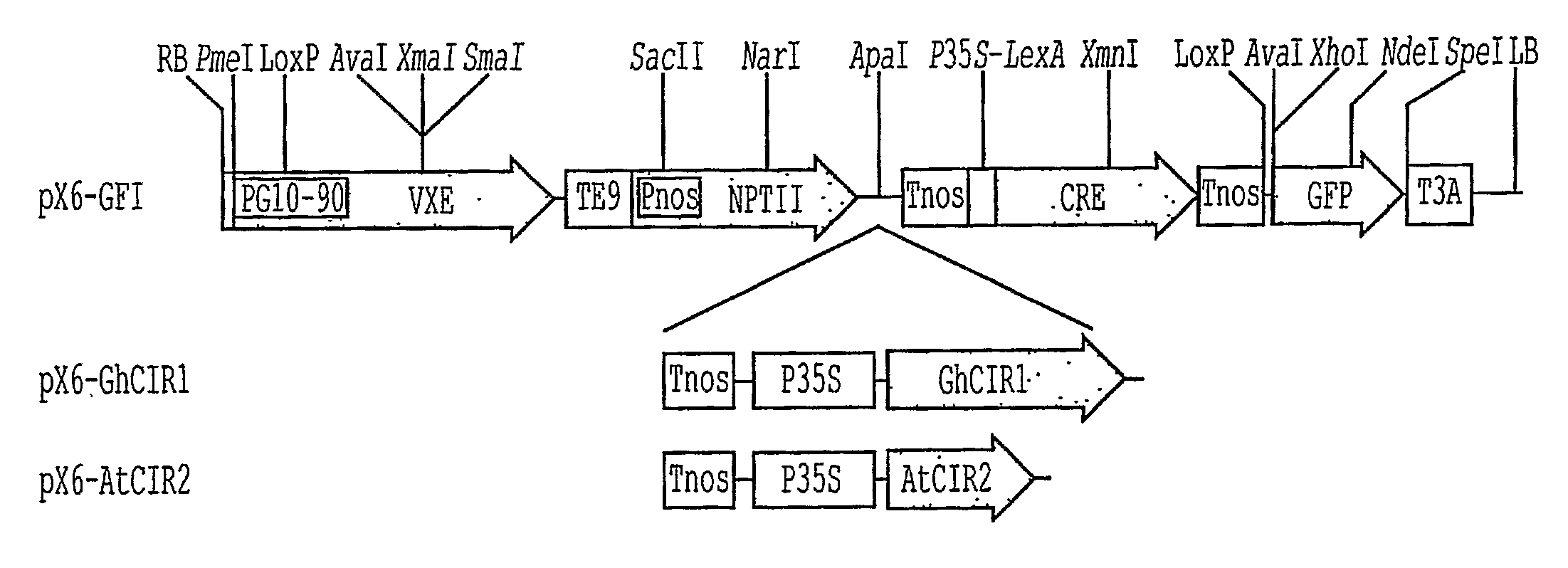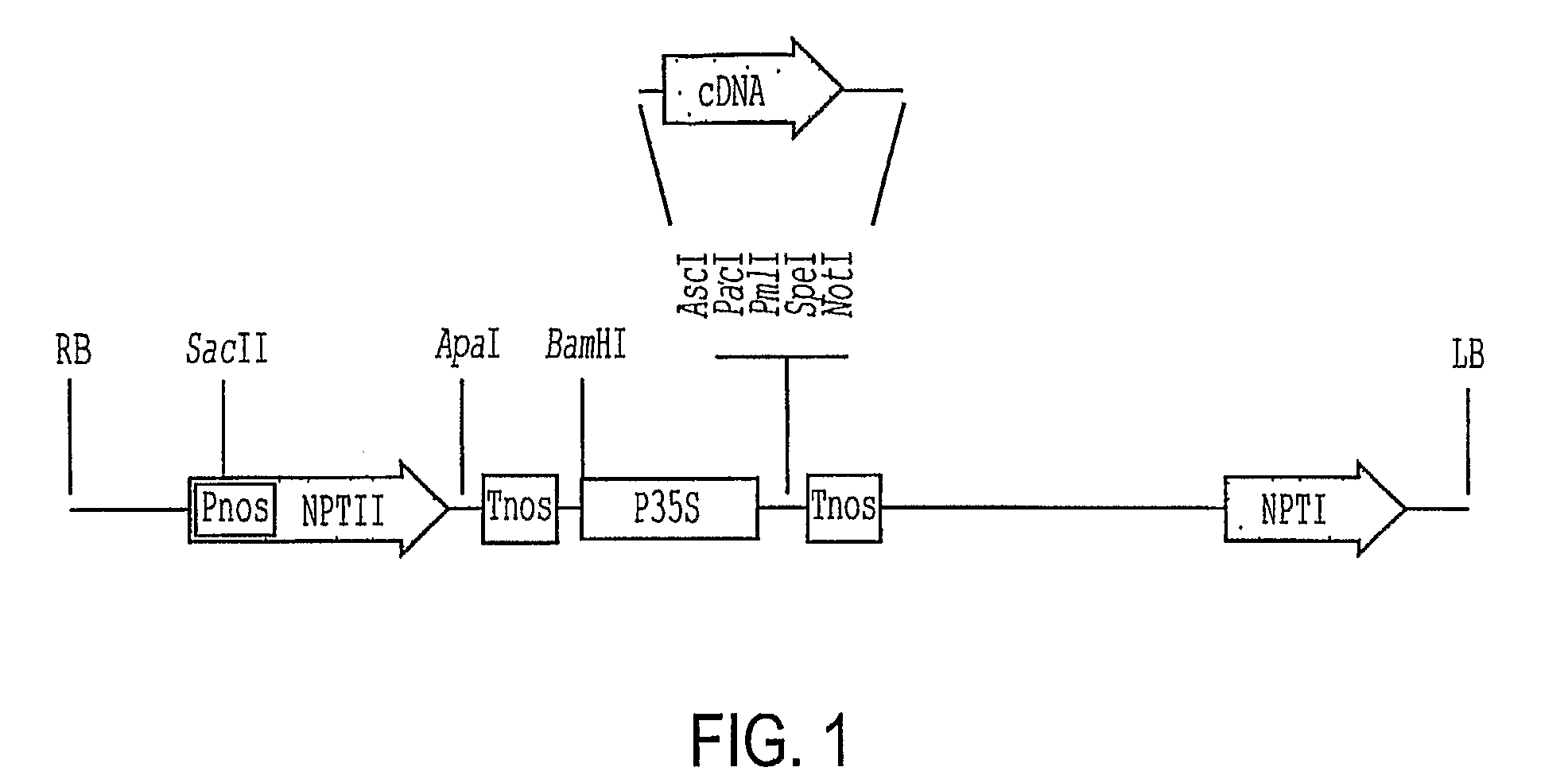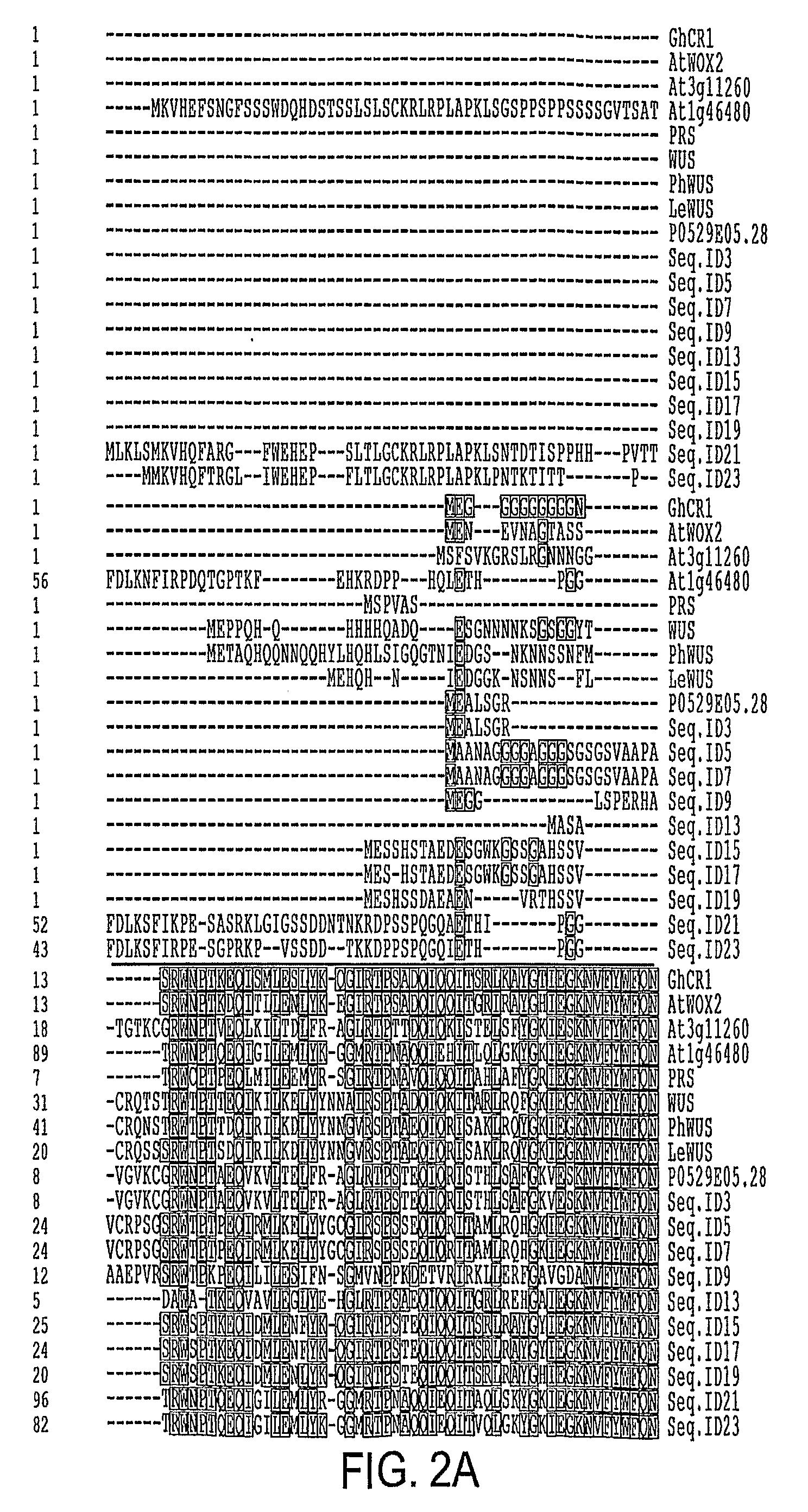Novel plant homeodomain protein-encoding genes and their uses
a technology of plant homeodomain and protein, applied in the field of polynucleotides, can solve the problems of affecting the regeneration efficiency of plants, affecting the growth and differentiation of plants, and presenting environmental or health risks, and achieve the effect of small drop in regeneration efficiency
- Summary
- Abstract
- Description
- Claims
- Application Information
AI Technical Summary
Benefits of technology
Problems solved by technology
Method used
Image
Examples
example 1
Construction of a Normalized cDNA Library
[0051]Total RNA was extracted from a pool of different cotton tissues which included somatic embryos, pro-embryogenic suspension cultures, roots, cotyledons, shoot tips and auxiliary shoot buds. Poly(A)+ RNA was isolated by PolyA-Tract™ mRNA purification system (Promoge™, UAS) and cDNA was synthesized with GeneRacer™ kit (Invitrogen™, USA). Approximately 0.75 μg polyA+ RNA was ligated with GeneRacer™ RNA oligo (CGACUGGAGCACGAGGACACUGACAUGGACUGAAGGAGUAGAAA [SEQ ID NO: 33]) and the mRNA was converted to single stranded cDNA using GeneRacer™ oligo dT primer (GCTGTCAACGATACGCTACGTAACGGCATGACAGTG(T)18 [SEQ ID NO: 34]). After RNaseH digestion, single-stranded cDNA was subtracted once with 1 μg biotinylated polyA+ mRNA (labelled with Ambion™ BrighStar™ psoralen-biotin labelling kit) from fully expanded leaves. Hybridized RNA / cDNA was removed with Streptavidin-magnetic beads (Promega™, USA) and the cDNA was recovered by isopropanol precipitation. A f...
example 2
Functional Screening of cDNA Libraries
[0052]Root transformation and cDNA library screening were carried out essentially as described by Banno et al., 2001. Approximately 100,000 transformation events were screened and four candidate calli were identified. One of the calli initially had a dark green appearance but later developed into shoots. DNA was extracted from the plantlets and cDNA inserts were recovered by amplification with Pfu DNA polymerase using primers GR5-2 and GR3-2P (TTTTTAATTAAGCTACGTAACGGCATGACAGTG [SEQ ID NO: 37]). A PCR product of approximately 1.1 Kb was generated and cloned between the AscI and PacI sites in pSK36 and pER10 (see Zou et al, 2002), respectively creating pSK36-GhCIR1 and pER10-GhCIR1. Subsequent DNA sequencing and BLAST search proved GhCIR1 is a novel gene. SEQ ID NOs: 1 and 2 show the cDNA and predicted protein sequences of GhCIR1. SEQ ID. No. 57 shows the protein encoding region (ORF) of GhCIR1
example 3
Cloning of Arabidopsis At5g59340, At3g11260 and At1g46480
[0053]At5g59340 (SEQ ID NO: 3) was amplified from genomic DNA using primers 59340U (AAGGCGCGCCATGGAAAACGAAGTAAACGCAG [SEQ ID NO: 38]) and 59340L (CGTTAATTAATTACAACCCATTACCATTACTATC [SEQ ID NO: 39]). The PCR products were digested with AscI and PacI and cloned into the corresponding sites in pSK36 or pER10. Its predicted protein sequence is shown in SEQ ID NO: 4. The Arabidopsis At3g11260 (SEQ ID NO: 5) and At1g46480 (SEQ ID NO: 7) genes were amplified by RT-PCR of total RNA extracted from young seedlings (Columbia-0) using primers 11260U (AAGGCGCGCCAGTTGAGGACTTTACATCTGAACA [SEQ ID NO: 40]) and 11260L (AATTAATTAACCATGCATTGGAAAATATCT [SEQ ID NO: 41]); and 46480U (AGGCGCGCCAAAATGAAGGTTCATGAGTTTTCGAATG [SEQ ID NO: 42]) and 46480L (AGTTAATTAATCATCTCCCTTCAGGATGGAGAGG [SEQ ID NO: 43]). The cDNA was cloned in pSK36 and pER10 between the AscI and PacI sites (FIG. 1). The DNA sequences of the clones were verified by DNA sequencing. The ...
PUM
| Property | Measurement | Unit |
|---|---|---|
| length | aaaaa | aaaaa |
| width | aaaaa | aaaaa |
| size | aaaaa | aaaaa |
Abstract
Description
Claims
Application Information
 Login to View More
Login to View More - R&D
- Intellectual Property
- Life Sciences
- Materials
- Tech Scout
- Unparalleled Data Quality
- Higher Quality Content
- 60% Fewer Hallucinations
Browse by: Latest US Patents, China's latest patents, Technical Efficacy Thesaurus, Application Domain, Technology Topic, Popular Technical Reports.
© 2025 PatSnap. All rights reserved.Legal|Privacy policy|Modern Slavery Act Transparency Statement|Sitemap|About US| Contact US: help@patsnap.com



